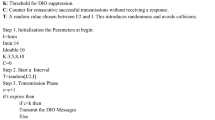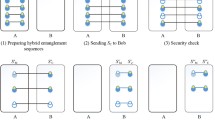Abstract
In this paper, we propose a novel quantum network coding scheme to achieve the perfect transmission of quantum states without loss of information. In our scheme, two pairs of non-maximally entangled states are pre-shared between senders. By applying the local operations at the sender, the perfect transmission of quantum states can be achieved on the butterfly network. Firstly, by adding auxiliary particles to the senders on the butterfly network, the senders can judge whether the quantum state transmission can be achieved or not in advance. The outstanding advantage of our scheme is that the transmission results of quantum states on the butterfly network can be predicted in advance. When the transmission fails, the quantum state will not be lost. The sender does not need to re-prepare the quantum state for retransmission. Secondly, in the proposed scheme, not only the resources of quantum channel and classical channel are greatly saved, but also only two-bit information is send through classical channel at the bottleneck. Thirdly, our scheme avoids preparing Bell basis to measure two-particle states and uses Z-basis and X-basis to measure single-particle states, which will make the experimental realization simplified. Finally, we also extend the scheme to the k-pair quantum network and give an example of quantum 3-pair network communication.











Similar content being viewed by others
References
Gisin, N., Thew, R.: Quantum communication. Nat. Photonics 1(3), 165 (2007)
Mattle, K., Weinfurter, H., Kwiat, P.G., et al.: Dense coding in experimental quantum communication. Phys. Rev. Lett. 76(25), 4656 (1996)
Duan, L.M., Lukin, M.D., Cirac, J.I., Zoller, P.: Long-distance quantum communication with atomic ensembles and linear optics. Nature 414(6862), 413 (2001)
Dai, J., Deng, Y.: A new method to predict the interference effect in quantum-like Bayesian networks. Soft. Comput. 2020, 1–8 (2020)
Gao, X., Deng, Y.: Quantum model of mass function. Int. J. Intell. Syst. 35(2), 267–282 (2020)
Deng, W., Deng, Y.: Entropic methodology for entanglement measures. Phys. A: Stat. Mech. Appl. 512, 693–697 (2018)
Bennett, C.H., Brassard, G., Crépeau, C., et al.: Teleporting an unknown quantum state via dual classical and Einstein–Podolsky–Rosen channels. Phys. Rev. Lett. 70(13), 1895 (1993)
Bouwmeester, D., Pan, J.W., Mattle, K., et al.: Experimental quantum teleportation. Nature 390(6660), 575 (1997)
Bennett, C.H., DiVincenzo, D.P., Shor, P.W., et al.: Remote state preparation. Phys. Rev. Lett. 87(7), 077902 (2001)
Leung, D.W., Shor, P.W.: Oblivious remote state preparation. Phys. Rev. Lett. 90(12), 127905 (2003)
Kurucz, Z., Adam, P., Kis, Z., et al.: Continuous variable remote state preparation. Phys. Rev. A 72(5), 052315 (2005)
Cirac, J.I., Ekert, A.K., Huelga, S.F., et al.: Distributed quantum computation over noisy channels. Phys. Rev. A 59(6), 4249 (1999)
Serafini, A., Mancini, S., Bose, S.: Distributed quantum computation via optical fibers. Phys. Rev. Lett. 96(1), 010503 (2006)
Shor, P.W., Preskill, J.: Simple proof of security of the BB84 quantum key distribution protocol. Phys. Rev. Lett. 85(2), 441 (2000)
Cerf, N.J., Bourennane, M., Karlsson, A., et al.: Security of quantum key distribution using d-level systems. Phys. Rev. Lett. 88(12), 127902 (2002)
Lo, H.K., Curty, M., Qi, B.: Measurement-device-independent quantum key distribution. Phys. Rev. Lett. 108(13), 130503 (2012)
Hayashi, M., Iwama, K., Nishimura, H.: Quantum network coding. In: Proceedings of the 24th Annual Conference on Theoretical Aspects of Computer Science. Berlin: Springer, pp. 610–621 (2007)
Hayashi, M.: Prior entanglement between senders enables perfect quantum network coding with modification. Phys. Rev. A 76(4), 040301 (2007)
Satoh, T., LeGall, F., Imai, H.: Quantum network coding for quantum repeaters. Phys. Rev. A 86(3), 032331 (2012)
Chen, X.B., Wang, Y.L., Xu, G., et al.: Quantum network communication with a novel discrete-time quantum walk. IEEE Access 7, 13634–13642 (2019)
Li, J., Chen, X.B., Xu, G., et al.: Perfect quantum network coding independent of classical network solutions. IEEE Commun. Lett. 19(2), 115–118 (2014)
Li, Z., Xu, G., Chen, X.B., et al.: Secure quantum network coding based on quantum homomorphic message authentication. Quantum Inf. Process. 18(1), 14 (2019)
Satoh, T., Ishizaki, K., Nagayama, S., et al.: Analysis of quantum network coding for realistic repeater networks. Phys. Rev. A 93(3), 032302 (2016)
Kobayashi, H., Le.Gall, F., Nishimura, H., Rotteler, M.: General scheme for perfect quantum network coding with free classical communication. In: Proceedings of 36th International Colloquium on Automata, Languages and Programming (ICALP), Lecture Note in Computer Science, vol. 5555, pp. 622-633 (2009)
Xu, G., Chen, X.B., Li, J., Wang, C., Yang, Y.X., Li, Z.P.: Network coding for quantum cooperative multicast. Quantum Inf. Process. 14(11), 4297–4322 (2015)
Epping, M., Kampermann, H., Bruss, D.: Robust entanglement distribution via quantum network coding. New J. Phys. 18(10), 103052 (2016)
Owari, M., Kato, G., Hayashi, M.: Single-shot secure quantum network coding on butterfly network with free public communication. Quantum Science and Technology 3(1), 014001 (2017)
Ahlswede, R., Cai, N., Li, S.Y.R., et al.: Network information flow. IEEE Trans. Inf. Theory 46, 1204–1216 (2000)
Holevo, A.S.: The capacity of the quantum channel with general signal states. IEEE Trans. Inf. Theory 44(1), 269–273 (1998)
Devetak, I.: The private classical capacity and quantum capacity of a quantum channel. IEEE Trans. Inf. Theory 51(1), 44–55 (2005)
Wootters, W.K., Zurek, W.H.: A single quantum cannot be cloned. Nature 299(5886), 802–803 (1982)
Bužek, V., Hillery, M.: Quantum copying: beyond the no-cloning theorem. Phys. Rev. A 54(3), 1844 (1996)
Kobayashi, H., Le.Gall, F., Nishimura, H., Rotteler, M.: Constructing quantum network coding schemes from classical nonlinear protocols. In: Proceedings of IEEE International Symposium Information Theory (ISIT), pp. 109–113 (2011)
Matsuo, T., Satoh, T., Nagayama, S., et al.: Analysis of measurement-based quantum network coding over repeater networks under noisy conditions. Phys. Rev. A 97(6), 062328 (2018)
Shang, T., Li, J., Pei, Z., et al.: Quantum network coding for general repeater networks. Quantum Inf. Process. 14(9), 3533–3552 (2015)
Shang, T., Li, K., Liu, J.: Continuous-variable quantum network coding for coherent states. Quantum Inf. Process. 16(4), 107 (2017)
Ma, S.Y., Chen, X.B., Luo, M.X., et al.: Probabilistic quantum network coding of M-qudit states over the butterfly network. Opt. Commun. 283(3), 497–501 (2010)
Zukowski, M., Zeilinger, A., Horne, M.A., et al.: “Event-ready-detectors” Bell experiment via entanglement swapping. Phys. Rev. Lett. 71, 4287–4290 (1993)
Bose, S., Vedral, V., Knight, P.L.: Multiparticle generalization of entanglement swapping. Phys. Rev. A 57(2), 822 (1998)
Van Meter, R., Touch, J., Horsman, C.: Recursive quantum repeater networks. Prog. Inform. 8, 65–79 (2011)
Carvalho, A.R.R., Mintert, F., Buchleitner, A.: Decoherence and multipartite entanglement. Phys. Rev. Lett. 93(23), 230501 (2004)
Marr, C., Beige, A., Rempe, G.: Entangled-state preparation via dissipation-assisted adiabatic passages. Phys. Rev. A 68(3), 033817 (2003)
Roa, L., Groiseau, C.: Probabilistic teleportation without loss of information. Phys. Rev. A 91(1), 012344 (2015)
Nielsen, M.A., Chuang, I.L.: Quantum Computation and Quantum Information. Cambridge University Press, Cambridge (2000)
Lo, H.K., Ma, X., Chen, K.: Decoy state quantum key distribution. Phys. Rev. Lett. 94(23), 230504 (2005)
Lim, C.C.W., Curty, M., Walenta, N., et al.: Concise security bounds for practical decoy-state quantum key distribution. Phys. Rev. A 89(2), 022307 (2014)
Sun, S.H., Tang, G.Z., Li, C.Y., et al.: Experimental demonstration of passive-decoy state quantum key distribution with two independent lasers. Phys. Rev. A 94(3), 032324 (2016)
Bennett, C.H., Brassard, G.: Quantum cryptography: public key distribution and coin tossing. In: International Conference on Computers, Systems and Signal Processing (Bangalore, India, Dec. 1984), pp. 175–179 (1984)
Lo, H.K., Chau, H.F.: Unconditional security of quantum key distribution over arbitrarily long distances. Science 283(5410), 2050–2056 (1999)
Sun, S.H., Tang, G.Z., Li, C.Y., et al.: Experimental demonstration of passive-decoystate quantum key distribution with two independent lasers. Phys. Rev. A 94(3), 032324 (2016)
Acknowledgements
This work is supported by NSFC (Grant Nos. 61671087, 61962009), the Fundamental Research Funds for the Central Universities (Grant No. 2019XD-A02), Huawei Technologies Co. Ltd (Grant No. YBN2020085019), the Open Foundation of Guizhou Provincial Key Laboratory of Public Big Data (Grant No. 2018BDKFJJ018).
Author information
Authors and Affiliations
Corresponding author
Additional information
Publisher's Note
Springer Nature remains neutral with regard to jurisdictional claims in published maps and institutional affiliations.
Rights and permissions
About this article
Cite this article
Pan, XB., Xu, G., Li, ZP. et al. Quantum network coding without loss of information. Quantum Inf Process 20, 65 (2021). https://doi.org/10.1007/s11128-020-02966-1
Received:
Accepted:
Published:
DOI: https://doi.org/10.1007/s11128-020-02966-1




